What is a volcano?
A volcano is a mountain that opens downward to a pool of molten rock below the surface of the earth. When pressure builds up, eruptions occur. Gases and rock shoot up through the opening and spill over or fill the air with lava fragments. Eruptions can cause lateral blasts, lava flows, hot ash flows, mudslides, avalanches, falling ash and floods. Volcano eruptions have been known to knock down entire forests. An erupting volcano can trigger tsunamis, flash floods, earthquakes, mudflows and rockfalls.

Click Here to learn more about volcanoes from USGS.
How are volcanoes formed?
Volcanoes are formed when magma from within the Earth's upper mantle works its way to the surface. At the surface, it erupts to form lava flows and ash deposits. Over time as the volcano continues to erupt, it will get bigger and bigger.
Why do volcanoes erupt?
The Earth's crust is made up of huge slabs called plates, which fit together like a jigsaw puzzle. These plates sometimes move. The friction causes earthquakes and volcanic eruptions near the edges of the plates. The theory that explains this process is called plate tectonics.

What are plate tectonics?
The theory of plate tectonics is a interesting story of continents drifting from place to place breaking apart, colliding, and grinding against each other. The plate tectonic theory is supported by a wide range of evidence that considers the earth's crust and upper mantle to be composed of several large, thin, relatively rigid plates that move relative to one another. The plates are all moving in different directions and at different speeds. Sometimes the plates crash together, pull apart or sideswipe each other. When this happens, it commonly results in earthquakes.
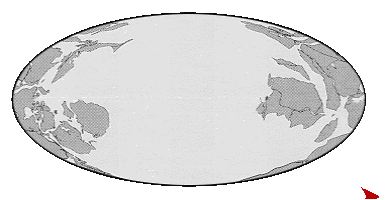 |
| Continental Drift: To see this animation again, just refresh this page!This animation shows you what our planet looked like millions of years ago and what it looks like now! (Graphic Credit: Geology Department at University of California, Berkeley) |
Click Here to learn more about plate tectonics and the drifting of our continents.
How many volcanoes are there?
There are more than 1500 active volcanoes on the Earth. We currently know of 80 or more which are under the oceans. Active volcanoes in the U.S. are found mainly in Hawaii, Alaska, California, Oregon and Washington.
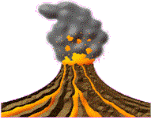
What are the different types of volcanoes?
Volcanoes are grouped into four types: cinder cones, composite volcanoes, shield volcanoes and lava volcanoes.
| Cinder Cones | Cinder cones are circular or oval cones made up of small fragments of lava from a single vent that have been blown into the air, cooled and fallen around the vent. |
Composite Volcanoes | Composite volcanoes are steep-sided volcanoes composed of many layers of volcanic rocks, usually made from high-viscosity lava, ash and rock debris. Mt. Rainier and Mount St. Helens are examples of this type of volcano. |
Shield Volcanoes | Shield volcanoes are volcanoes shaped like a bowl or shield in the middle with long gentle slopes made by basaltic lava flows. Basalt lava flows from these volcanoes are called flood basalts. The volcanoes that formed the basalt of the Columbia Plateau were shield volcanoes. |
| Lava Volcanoes | Lava domes are formed when erupting lava is too thick to flow and makes a steep-sided mound as the lava piles up near the volcanic vent. The eruption of Mount St. Helens in 1980 was caused in part by a lava dome shifting to allow explosive gas and steam to escape from inside the mountain. |
What is the difference between lava and magma?
Magma is liquid rock inside a volcano. Lava is liquid rock (magma) that flows out of a volcano. Fresh lava glows red hot to white hot as it flows.

Why does lava take a long time to cool down?
Lava cools slowly because lava is a poor conductor of heat. Lava flows slow down and thicken as they harden.
What is a pyroclastic flow?
A pyroclastic flow is a fluidized mixture of solid to semi-solid fragments and hot, expanding gases that flows down the sides of a volcano. These awesome features are heavier-than-air emulsions that move much like a snow avalanche, except that they are fiercely hot, contain toxic gases, and move at phenomenal, hurricane-force speeds. They are the most deadly of all volcanic phenomena.
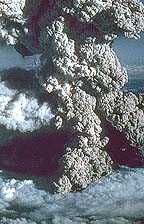
What is lahar?
A lahar is a type of mudflow or debris flow composed of pyroclastic material, rocky debris, and water. The material flows down from a volcano, typically along a river valley. It is very dangerous because it's consistency and the way it acts is very much like cement. It is liquid when it's moving, but when it stops, it solidifies. This can cause just as much devastation as lava itself.
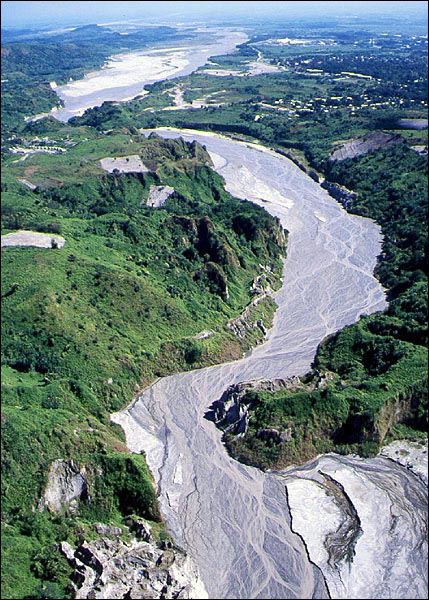
What is pumice?
Pumice is a light, porous volcanic rock that forms during explosive eruptions. It resembles a sponge because it consists of a network of gas bubbles frozen amidst fragile volcanic glass and minerals. All types of magma (basalt, andesite, dacite, and rhyolite) will form pumice.

What is the largest active volcano?
The world's largest, active volcano is Mauna Loa in Hawaii, where famous coffee is grown in the rich volcanic soils. Mauna Loa is 13,677 feet above sea level. From its base below sea level to its summit, Mauna Loa is taller than Mount Everest.
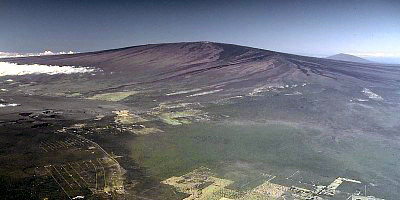
What is the Ring of Fire?
The Pacific Ring of Fire is an area of frequent earthquakes and volcanic eruptions encircling the basin of the Pacific Ocean. The Ring of Fire has 452 volcanoes and is home to over 50% of the world's active and dormant volcanoes. Ninety percent of the world's earthquakes and 81% of the world's largest earthquakes occur along the Ring of Fire.
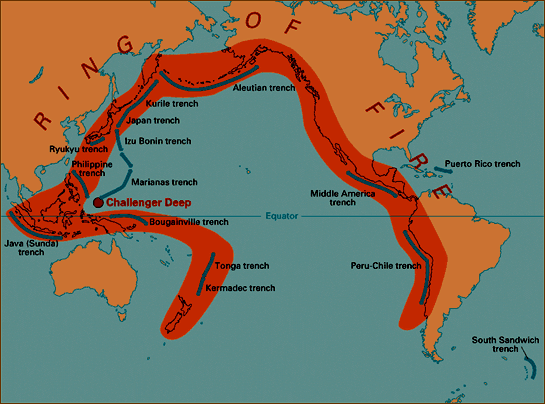
When did Mount St. Helens erupt?
On May 18, 1980, Mount St. Helens erupted. It's located in southwestern Washington State in the Cascade Range. The blast was heard as far away as Montana, Idaho, Canada and California. Fifty-seven people died and the eruption caused $1.2 billion in damage.
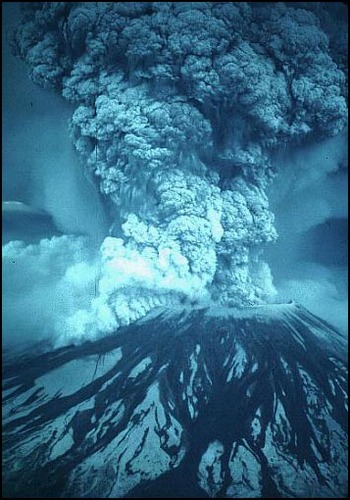
Click Here to learn more about Mount St. Helens.
Click Here for more info on Mount St. Helens.
What is a tsunami?
A tsunami is a large ocean wave usually caused by an underwater earthquake or a volcanic explosion. Tsunamis are NOT tidal waves. Tidal waves are caused by the forces of the moon, sun, and planets upon the tides, as well as the wind as it moves over the water. With typical waves, water flows in circles, but with a tsunami, water flows straight. This is why tsunamis cause so much damage!
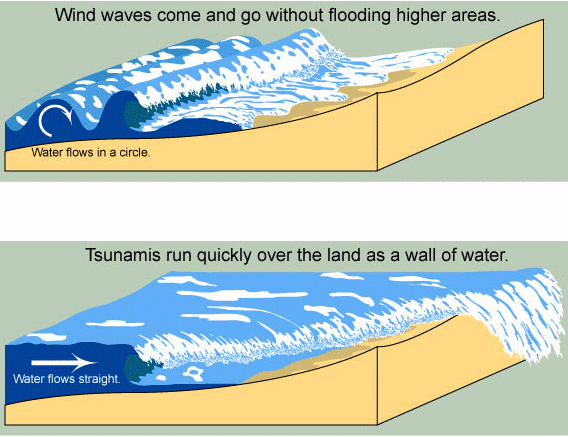
Click Here to see an animation of an earthquake and the resulting tsunami. It's great for kids, because they get to see how it actually happens!
Click Here to get the latest tsunami warning information from the NWS.
Click Here for tsunami safety information.
MAGMA - Magma is the liquid rock inside a volcano.
LAVA - Lava is the liquid rock (magma) that flows out of a volcano. Lava glows red hot to white hot as it flows.
ACTIVE VOLCANO - An active volcano is one that erupts regularly.
DORMANT VOLCANO - A dormant volcano is one that has not erupted for many years, although there is still some activity deep inside.
EXTINCT VOLCANO - An extinct volcano is a volcano that is no longer active.
GEYSERS - Geysers are springs that throw boiling water high in the air. They are caused by volcanic heat warming trapped ground water.
ASH - Ash are very small fragments of lava or rock blasted into the air by volcanic explosions.
PUMICE - It is a light-colored volcanic rock containing lots of bubbles from trapped gases.
Click Here to see if there has been any recent volcanic activity across the U.S.
PLAN FOR A VOLCANO: First of all, have a disaster plan and know whether or not you are at risk for danger. Be prepared for mudslides, flash floods, earthquakes, ash falling, acid rain and tsunamis. Prepare a disaster supplies kit for your home and car. Include a first aid kit, canned food and a can opener, bottled water, battery-operated radio, flashlight, protective clothing, dust mask, goggles and sturdy shoes. Don't forget, know all of your evacuation routes.
DURING A VOLCANO: Follow the evacuation order issued by authorities. Avoid areas downwind and river valleys downstream of the volcano. If your caught indoors, close all windows and doors, put machinery inside a barn, and bring animals inside. If you’re trapped outdoors, seek shelter indoors. If you’re caught in falling rocks, roll into a ball and protect your head. If you’re caught near a stream, be aware of mudflows and move to higher ground. Protect yourself when ash falls by wearing long-sleeved shirts and long pants. Use goggles to protect your eyes. Wear a dust mask and keep car engines off.
AFTER A VOLCANO: Cover you mouth and nose. Volcanic ash can irritate your respiratory system. Wear goggles and protect your eyes. Keep your skin covered. Clear roofs of ash, because the ash is very heavy and can cause the building to collapse.

No comments:
Post a Comment